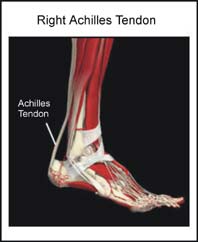In order to understand this condition, it is important to understand the anatomy and function of the foot. Please read Foot Pain Info’s section on basic ankle anatomy. For additional background information on the biomechanics of the foot please read Foot Pain Info ‘s section on basic foot and ankle biomechanics.

What is the Achilles tendon and what is its function?
Many of the muscles that move the foot are found in the lower leg. These muscles attach via tendons to various bones in the foot. The main muscles that move the foot downwards (plantar flex the foot) and propel the body forward are the calf muscles (gastrocnemius and soleus muscles). These muscles are connected to the heel bone (calcaneus) by the “rope like” Achilles tendon.
What is an Achilles tendon rupture?
Achilles tendon rupture is the term used to describe a complete tear of the Achilles tendon. The most common site for Achilles tendon rupture to occur is an area 2 – 6 cm. (1 – 2.5 in.) above where the tendon attaches to the calcaneus.
What does an Achilles tendon rupture feel like?
The pain from an Achilles tendon rupture is usually felt in the back of the lower leg, in the area 2 to 6 cm. above the Achilles tendon’s attachment to the calcaneus. Individuals with an Achilles tendon rupture often describe a “pop” or similar feeling at the time of the injury. A “hole” or defect in the Achilles tendon can usually be felt under the skin in this area. A limp and inability to rise up on the toes of the affected foot are usually present. If the affected foot does not plantar flex when the calf muscles are squeezed an Achilles tendon rupture is very likely.
What causes the Achilles tendon to rupture?
The Achilles tendon usually ruptures as a result of a sudden forceful contraction of the calf muscles. Activities such as jumping, lunging, or sprinting can cause undue stress on the Achilles tendon and cause it to rupture. Often there is a background of Achilles tendinitis. Direct trauma to the area, poor flexibility or weakness of the calf muscles or of the Achilles tendon and increasing age are some of the other factors that are associated with an Achilles tendon rupture.
Can Achilles tendon rupture be detected on X-rays?
The actual area of an Achilles tendon rupture cannot be seen on x-ray. Therefore, although x-rays are often done to rule out bony injuries in individuals with an Achilles tendon rupture these x-rays are usually normal. Diagnostic ultrasound of the tendon can be performed to assess the integrity of the tendon. Other diagnostic tests, such as MRI’s, may also be required in difficult cases.
What is the treatment for Achilles tendon rupture?
The treatment of Achilles tendon rupture should be individualized. Most complete tears require surgery. Some partial tears can be treated with a cast. Orthopedic surgeons are trained to determine which Achilles tendon ruptures require surgery.
What other information is available on Achilles tendon rupture?
Foot Pain Info ‘s links section has additional information on this topic. Links have been provided to other websites as well as online medical journals. Visit Joint Pain Info for information on other joint injuries and problems.
